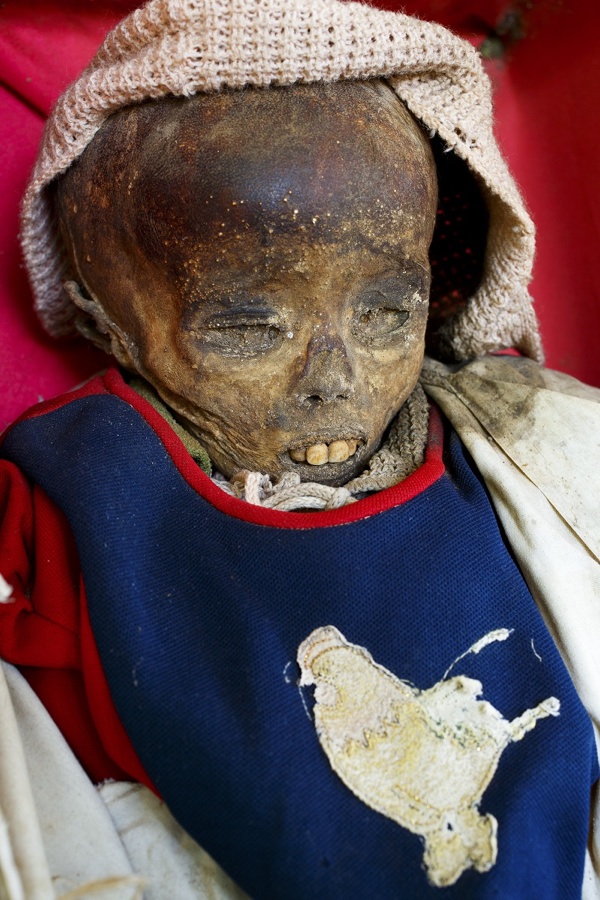
Burial cave in Sulawesi, Indonesia. All photos in this post courtesy of and © Paul Koudounaris
I’ve spent the past dozen years traveling around the world and documenting the visual culture of death, primarily involving decorated bones and sacred sites where human remains are displayed. This sometimes quixotic quest has resulted in a trio of books (Empire of Death, Heavenly Bodies, and the latest, Memento Mori, being released at the Luz de Jesus Gallery tonight) and continues to take me to places that even now manage to surprise me. In the process, I have come to realize just how indoctrinated I am as a westerner in certain ways of thinking about death.
 One of my favorite episodes, favored enough that I used it in the introduction of my latest book, occurred in the Tana Toraja region of the Indonesian island of Sulawesi.
One of my favorite episodes, favored enough that I used it in the introduction of my latest book, occurred in the Tana Toraja region of the Indonesian island of Sulawesi.
A couple of years before I had gone to the island primarily to research burial caves and funerary customs, but I had a further interest in a tradition of dressing and displaying mummies in some of the local villages. So I inquired of a guide whether he knew of any families nearby that had such a mummy that I could photograph. He did, and we went to a home where a fully robed, mummified girl was kept in an open-faced wooden case. The family had found the girl, whose identity was unknown to them, in a cave, and adopted her as a daughter.

Mummified girl in Sulawesi, Indonesia
I photographed the mummy and spoke to the family. Afterward I asked my guide if it was considered at all unusual to keep a mummy in the household, and he explained that no, it was not unusual to him, since when he was a child he and his brothers used to sleep in the same bed with his grandfather, and that each morning they would dress the corpse in its day clothes and set it upright, and in the evening dress it in pajamas and place it back in the bed. My reaction was one of shock—not in a horrified way, because ten years in, there was really nothing that could horrify me—but the kind of shock one feels when you think you’ve seen it all, and then you find something you never expected. He used to sleep with the mummy of his grandfather? I never saw that coming, not even an inkling, and it provided a reminder that even after a decade of constantly and obsessively traveling the world and collecting information on how people might deal with the dead, I still had blinders that needed to be removed.
The most fundamental lesson I think I’ve learned through all of my research is that we as Westerners are the weird ones when it comes to death. If you look cross-culturally and historically at the way people interacted with the dead, there are in fact a lot of constants. There is a nearly universal need to preserve a dialogue with those who have passed on and allow them a role in society. That doesn’t mean that there are a bunch of people throughout history who have been sleeping with their grandfathers’ mummies—there are other ways this need can be expressed.
The dressed mummies that were once common in Sicily, in towns like Palermo, Burgio, Gangi, and many others, seem so Norman Bates now, but they are an expression of this desire. So are the painted skulls that can still be found in Hallstatt, Austria, and were once present in many other Alpine villages. As are the lovingly preserved bodies still hidden away in caves in Central Luzon, in the Philippines. And there are so many other examples from around the world, even in contemporary society—in Bolivia, for instance, where an annual skull festival is held that attracts, at least in La Paz, thousands of people.

19th-century mummy in Burgio, Sicily

Painted skulls in Hallstatt, Austria

Mummies in a burial cave, Luzon, Philippines

Skull with flowers in La Paz, Bolivia
Not all societies have been so overt about it. In ancient Rome, for instance, they didn’t go around displaying clothed corpses, but there were still rites and rituals related to ancestor worship that were considered important and that needed to be observed. But then there’s us, in the modern West. After the Enlightenment, we made a very determined effort to shut down that line of contact, to ghettoize the dead and push them away—as I like to say, to truly kill the dead.
Since I am one of the few people who has spoken at all of the Death Salons held thus far, people will sometimes ask me what it’s about. On a personal level, based on the material I have presented, it’s simply about asking people if they might want to reconsider what they think they know about death and the role that of the dead within society. To me, Death Salon has no answers, but it has questions. These questions are fundamentally important as we move forward as a culture, since our attitudes towards death will continue to evolve, hopefully in as healthy a way as possible.
_____
Paul Koudounaris’s photographs are on view at the Luz de Jesus Gallery in Hollywood, April 3–26, 2015.
Paul discusses catacomb saints at Death Salon Getty Villa on April 26. Tickets are sold out, but we invite you to follow the day’s events on Twitter at #DeathSalonGV. Audio of all talks will be posted after the event.




A great piece by the inspiring Paul Koudounaris.
Susan, Natural Death Centre charity, UK @ndccharity
I would say that universally, humans have never come to understand the Supernatural. Death is simply the doorway that we come to without having a key or formula to open and explore past it. Yes, we have ritual and many forms of spurious psychic contact, but Death remains quite simply the unexplained and the region in which all is of necessity UNEXPLAINABLE except thru speculation and hope. Death is the one unrelenting partner that is with us each moment throughout life and yet remains permanently the BEYOND to which we can only aspire to find clues as to its basis and nature.Therefore, I would declare that Death is more important than life because without it and its mysteries, we would have no life at all.
I think the western civilisation won’t accept the death no longer as it is possible to be forever young with Botox and so on. We’ve lost to look and to live with the death, accepting it like birth and growing up. However, most of people can’t handle with their own natural outlook and considering the death as a an ugly thing. Old rites unfortunately are gone in our western society and therefore also respect and honouring our forefathers and ancestors with gentle gests. I’ve written in my own blog about the light of death for a gone soul and it’s meaning through all epoches and changing times. The beauty of death have many faces, but it’s still about to learn, to see and accept it again in our society,- not to fear it.
Nice greetings from Augsburg, Germany
It is only recently that westerners have become “weird” about death. As a child, my father visited the bones of his ancestors that were laid on the shelf of caves in middle Tennessee. And when TVA flooded our farm land, we moved our bones to the mountains.
I make some cool art about death. And I was the part of the first celebration of the day of the dead with Self Help Graphics. See my website.
lamajaart.com.